Determining the Protective Efficacy of Toll-Like Receptor Ligands to Minimize H9N2 Avian Influenza Virus Transmission in Chickens
Abstract
1. Introduction
2. Materials and Methods
2.1. Chickens
2.2. Avian Influenza Virus Propagation and Infection in Chickens
2.3. TLR Ligands
2.4. Experimental Design
2.5. Virus Isolation
2.6. Hemagglutination Inhibition (HI) Assay
2.7. RNA Extraction, cDNA Synthesis and Real- Time PCR
2.8. Statistical Analysis
3. Results
3.1. Trial 1
3.1.1. Administration of TLR Ligands Reduces Oral and Cloacal Shedding in Seeder Chickens
3.1.2. Poly(I:C) and CpG ODN 2007 Reduce the Transmission of H9N2 AIV in Recipient Chickens
3.2. Trial 2
3.2.1. H9N2 AIV Infection within the Seeder Groups
3.2.2. Treatment with Poly(I:C) and CpG ODN 2007 Affects the Transmission of H9N2 AIV in Recipient Chickens
3.2.3. Identifying the Corelates of Immunity in the Spleen, Cecal Tonsils and Lungs in TLR Ligand Treated Chickens
Spleen
Cecal Tonsils
Lungs
Administration of CpG ODN 2007 Induces a Higher Level of HI Antibodies Compared to Poly(I:C)
4. Discussion
Supplementary Materials
Author Contributions
Funding
Institutional Review Board Statement
Informed Consent Statement
Data Availability Statement
Acknowledgments
Conflicts of Interest
References
- Bouvier, N.M.; Palese, P. The biology of influenza viruses. Vaccine 2008, 26, D49–D53. [Google Scholar] [CrossRef] [PubMed]
- Alexander, D.J. A review of avian in¯uenza in different bird species. Vet. Microbiol. 2000, 74, 3–13. [Google Scholar] [CrossRef]
- Suarez, D.L. Avian influenza: Our current understanding. Anim. Health Res. Rev. 2010, 11, 19–33. [Google Scholar] [CrossRef]
- Cáceres, C.J.; Rajao, D.S.; Perez, D.R. Airborne Transmission of Avian Origin H9N2 Influenza A Viruses in Mammals. Viruses 2021, 13, 1919. [Google Scholar] [CrossRef]
- Li, X.; Shi, J.; Guo, J.; Deng, G.; Zhang, Q.; Wang, J.; He, X.; Wang, K.; Chen, J.; Li, Y.; et al. Genetics, Receptor Binding Property, and Transmissibility in Mammals of Naturally Isolated H9N2 Avian Influenza Viruses. PLoS Pathog. 2014, 10, e1004508. [Google Scholar] [CrossRef]
- Guo, J.; Wang, Y.; Zhao, C.; Gao, X.; Zhang, Y.; Li, J.; Wang, M.; Zhang, H.; Liu, W.; Wang, C.; et al. Molecular characterization, receptor binding property, and replication in chickens and mice of H9N2 avian influenza viruses isolated from chickens, peafowls, and wild birds in eastern China. Emerg. Microbes Infect. 2021, 10, 2098–2112. [Google Scholar] [CrossRef] [PubMed]
- Nagy, A.; Mettenleiter, T.C.; Abdelwhab, E.M. A brief summary of the epidemiology and genetic relatedness of avian influenza H9N2 virus in birds and mammals in the Middle East and North Africa. Epidemiol. Infect. 2017, 145, 3320–3333. [Google Scholar] [CrossRef]
- Thuy, D.M.; Peacock, T.P.; Bich, V.T.N.; Fabrizio, T.; Hoang, D.N.; Tho, N.D.; Diep, N.T.; Nguyen, M.; Hoa, L.N.M.; Trang, H.T.T.; et al. Prevalence and diversity of H9N2 avian influenza in chickens of Northern Vietnam, 2014. Infect. Genet. Evol. 2016, 44, 530–540. [Google Scholar] [CrossRef]
- Peacock, T.P.; James, J.; Sealy, J.E.; Iqbal, M. A Global Perspective on H9N2 Avian Influenza Virus. Viruses 2019, 11, 620. [Google Scholar] [CrossRef] [PubMed]
- Zhou, J.; Wu, J.; Zeng, X.; Huang, G.; Zou, L.; Song, Y.; Gopinath, D.; Zhang, X.; Kang, M.; Lin, J.; et al. Isolation of H5N6, H7N9 and H9N2 avian influenza A viruses from air sampled at live poultry markets in China, 2014 and 2015. Eurosurveillance 2016, 21, 30331. [Google Scholar] [CrossRef]
- Ferro, P.J.; Budke, C.M.; Peterson, M.J.; Cox, D.; Roltsch, E.; Merendino, T.; Nelson, M.; Lupiani, B. Multiyear Surveillance for Avian Influenza Virus in Waterfowl from Wintering Grounds, Texas Coast, USA. Emerg. Infect. Dis. 2010, 16, 7. [Google Scholar] [CrossRef]
- Yassine, H.M.; Lee, C.-W.; Gourapura, R.; Saif, Y.M. Interspecies and intraspecies transmission of influenza A viruses: Viral, host and environmental factors. Anim. Health Res. Rev. 2010, 11, 53–72. [Google Scholar] [CrossRef] [PubMed]
- Kye, S.-J.; Park, M.-J.; Kim, N.-Y.; Lee, Y.-N.; Heo, G.-B.; Baek, Y.-K.; Shin, J.-I.; Lee, M.-H.; Lee, Y.-J. Pathogenicity of H9N2 low pathogenic avian influenza viruses of different lineages isolated from live bird markets tested in three animal models: SPF chickens, Korean native chickens, and ducks. Poult. Sci. 2021, 100, 101318. [Google Scholar] [CrossRef]
- Iqbal, M.; Yaqub, T.; Mukhtar, N.; Shabbir, M.Z.; McCauley, J.W. Infectivity and transmissibility of H9N2 avian influenza virus in chickens and wild terrestrial birds. Vet. Res. 2013, 44, 100. [Google Scholar] [CrossRef] [PubMed]
- Saenz, R.A.; Essen, S.C.; Brookes, S.M.; Iqbal, M.; Wood, J.L.N.; Grenfell, B.T.; McCauley, J.W.; Brown, I.H.; Gog, J.R. Quantifying Transmission of Highly Pathogenic and Low Pathogenicity H7N1 Avian Influenza in Turkeys. PLoS ONE 2012, 7, e45059. [Google Scholar] [CrossRef]
- Wang, J.; Wu, M.; Hong, W.; Fan, X.; Chen, R.; Zheng, Z.; Zeng, Y.; Huang, R.; Zhang, Y.; Lam, T.T.-Y.; et al. Infectivity and Transmissibility of Avian H9N2 Influenza Viruses in Pigs. J. Virol. 2016, 90, 3506–3514. [Google Scholar] [CrossRef]
- World Health Organization. Manual for the Laboratory Diagnosis and Virological Surveillance of Influenza; World Health Organization: Geneva, Switzerland, 2011. [Google Scholar]
- Zhang, G.; Xu, L.; Zhang, J.; Fang, Q.; Zeng, J.; Liu, Y.; Ke, C. A H9N2 Human Case and Surveillance of Avian Influenza Viruses in Live Poultry Markets—Huizhou City, Guangdong Province, China, 2021. China CDC Wkly. 2022, 4, 8–10. [Google Scholar] [CrossRef]
- Alqazlan, N.; Astill, J.; Raj, S.; Sharif, S. Strategies for enhancing immunity against avian influenza virus in chickens: A review. Avian Pathol. 2022, 51, 211–235. [Google Scholar] [CrossRef]
- Kapczynski, D.R.; Swayne, D.E. Influenza Vaccines for Avian Species. In Vaccines for Pandemic Influenza; Compans, W., Orenstein, W.A., Eds.; Springer: Berlin/Heidelberg, Germany, 2009; pp. 133–152. [Google Scholar] [CrossRef]
- Singh, S.M.; Alkie, T.N.; Hodgins, D.C.; Nagy, É.; Shojadoost, B.; Sharif, S. Systemic immune responses to an inactivated, whole H9N2 avian influenza virus vaccine using class B CpG oligonucleotides in chickens. Vaccine 2015, 33, 3947–3952. [Google Scholar] [CrossRef] [PubMed]
- Van der Goot, J.A.; Koch, G.; de Jong, M.C.M.; van Boven, M. Quantification of the effect of vaccination on transmission of avian influenza (H7N7) in chickens. Proc. Natl. Acad. Sci. USA. 2005, 102, 18141–18146. [Google Scholar] [CrossRef] [PubMed]
- Abdul-Cader, M.S.; Ahmed-Hassan, H.; Amarasinghe, A.; Nagy, E.; Sharif, S.; Abdul-Careem, M.F. Toll-like receptor (TLR)21 signalling-mediated antiviral response against avian influenza virus infection correlates with macrophage recruitment and nitric oxide production. J. Gen. Virol. 2017, 98, 1209–1223. [Google Scholar] [CrossRef] [PubMed]
- Barjesteh, N.; Behboudi, S.; Brisbin, J.T.; Villanueva, A.I.; Nagy, E.; Sharif, S. TLR ligands induce antiviral responses in chicken macrophages. PLoS ONE 2014, 9, e105713. [Google Scholar] [CrossRef]
- St Paul, M.; Mallick, A.I.; Haq, K.; Orouji, S.; Abdul-Careem, M.F.; Sharif, S. In vivo administration of ligands for chicken toll-like receptors 4 and 21 induces the expression of immune system genes in the spleen. Vet. Immunol. Immunopathol. 2011, 144, 228–237. [Google Scholar] [CrossRef] [PubMed]
- Brownlie, R.; Allan, B. Avian toll-like receptors. Cell Tissue Res. 2011, 343, 121–130. [Google Scholar] [CrossRef] [PubMed]
- Karpala, A.J.; Lowenthal, J.W.; Bean, A.G. Activation of the TLR3 pathway regulates IFNβ production in chickens. Dev. Comp. Immunol. 2008, 32, 435–444. [Google Scholar] [CrossRef] [PubMed]
- St. Paul, M.; Brisbin, J.T.; Abdul-Careem, M.F.; Sharif, S. Immunostimulatory properties of Toll-like receptor ligands in chickens. Vet. Immunol. Immunopathol. 2013, 152, 191–199. [Google Scholar] [CrossRef]
- Temperley, N.D.; Berlin, S.; Paton, I.R.; Griffin, D.K.; Burt, D.W. Evolution of the chicken Toll-like receptor gene family: A story of gene gain and gene loss. BMC Genom. 2008, 9, 62. [Google Scholar] [CrossRef]
- Akira, S.; Uematsu, S.; Takeuchi, O. Pathogen Recognition and Innate Immunity. Cell 2006, 124, 783–801. [Google Scholar] [CrossRef]
- Bavananthasivam, J.; Alkie, T.N.; Matsuyama-Kato, A.; Hodgins, D.C.; Sharif, S. Characterization of innate responses induced by in ovo administration of encapsulated and free forms of ligands of Toll-like receptor 4 and 21 in chicken embryos. Res. Vet. Sci. 2019, 125, 405–415. [Google Scholar] [CrossRef]
- Bavananthasivam, J.; Kulkarni, R.R.; Read, L.; Sharif, S. Reduction of Marek’s Disease Virus Infection by Toll-Like Receptor Ligands in Chicken Embryo Fibroblast Cells. Viral Immunol. 2018, 31, 389–396. [Google Scholar] [CrossRef]
- Dar, A.; Potter, A.; Tikoo, S.; Gerdts, V.; Lai, K.; Babiuk, L.A.; Mutwiri, G. CpG Oligodeoxynucleotides Activate Innate Immune Response that Suppresses Infectious Bronchitis Virus Replication in Chicken Embryos. Avian Dis. 2009, 53, 261–267. [Google Scholar] [CrossRef] [PubMed]
- Kannaki, T.R.; Reddy, M.R.; Shanmugam, M.; Verma, P.C.; Sharma, R.P. Chicken toll-like receptors and their role in immunity. World’s Poult. Sci. J. 2010, 66, 727–738. [Google Scholar] [CrossRef]
- Hopkins, P.A.; Sriskandan, S. Mammalian Toll-like receptors: To immunity and beyond. Clin. Exp. Immunol. 2005, 140, 395–407. [Google Scholar] [CrossRef]
- St. Paul, M.; Mallick, A.I.; Read, L.R.; Villanueva, A.I.; Parvizi, P.; Abdul-Careem, M.F.; Nagy, É.; Sharif, S. Prophylactic treatment with Toll-like receptor ligands enhances host immunity to avian influenza virus in chickens. Vaccine 2012, 30, 4524–4531. [Google Scholar] [CrossRef] [PubMed]
- Barjesteh, N.; Alkie, T.N.; Hodgins, D.C.; Nagy, É.; Sharif, S. Local Innate Responses to TLR Ligands in the Chicken Trachea. Viruses 2016, 8, 207. [Google Scholar] [CrossRef]
- Reed, L.J.; Muench, H. A simple method of estimating fifty per cent endpoints. Am. J. Epidemiol. 1938, 27, 493–497. [Google Scholar] [CrossRef]
- Brisbin, J.T.; Gong, J.; Parvizi, P.; Sharif, S. Effects of Lactobacilli on Cytokine Expression by Chicken Spleen and Cecal Tonsil Cells. Clin. Vaccine Immunol. CVI 2010, 17, 1337–1343. [Google Scholar] [CrossRef]
- Villanueva, A.I.; Kulkarni, R.R.; Sharif, S. Synthetic double-stranded RNA oligonucleotides are immunostimulatory for chicken spleen cells. Dev. Comp. Immunol. 2011, 35, 28–34. [Google Scholar] [CrossRef]
- Barjesteh, N.; Shojadoost, B.; Brisbin, J.T.; Emam, M.; Hodgins, D.C.; Nagy, É.; Sharif, S. Reduction of avian influenza virus shedding by administration of Toll-like receptor ligands to chickens. Vaccine 2015, 33, 4843–4849. [Google Scholar] [CrossRef]
- Brisbin, J.T.; Zhou, H.; Gong, J.; Sabour, P.; Akbari, M.R.; Haghighi, H.R.; Yu, H.; Clarke, A.; Sarson, A.J.; Sharif, S. Gene expression profiling of chicken lymphoid cells after treatment with Lactobacillus acidophilus cellular components. Dev. Comp. Immunol. 2008, 32, 563–574. [Google Scholar] [CrossRef]
- Capua, I.; Terregino, C.; Cattoli, G.; Mutinelli, F.; Rodriguez, J.F. Development of a DIVA (Differentiating Infected from Vaccinated Animals) strategy using a vaccine containing a heterologous neuraminidase for the control of avian influenza. Avian Pathol. 2003, 32, 47. [Google Scholar] [CrossRef] [PubMed]
- Barjesteh, N.; O’Dowd, K.; Vahedi, S.M. Antiviral responses against chicken respiratory infections: Focus on avian influenza virus and infectious bronchitis virus. Cytokine 2020, 127, 154961. [Google Scholar] [CrossRef] [PubMed]
- Engel, A.L.; Holt, G.E.; Lu, H. The pharmacokinetics of Toll-like receptor agonists and the impact on the immune system. Expert Rev. Clin. Pharmacol. 2011, 4, 275–289. [Google Scholar] [CrossRef]
- Kimani, F.W.; Ajit, J.; Galluppi, A.; Manna, S.; Howitz, W.J.; Tang, S.; Esser-Kahn, A.P. Receptor-Ligand kinetics influence the mechanism of action of covalently linked TLR ligands. ACS Chem. Biol. 2021, 16, 380–388. [Google Scholar] [CrossRef] [PubMed]
- Patel, B.A.; Gomis, S.; Dar, A.; Willson, P.J.; Babiuk, L.A.; Potter, A.; Mutwiri, G.; Tikoo, S.K. Oligodeoxynucleotides containing CpG motifs (CpG-ODN) predominantly induce Th1-type immune response in neonatal chicks. Dev. Comp. Immunol. 2008, 32, 1041–1049. [Google Scholar] [CrossRef] [PubMed]
- St. Paul, M.; Paolucci, S.; Read, L.R.; Sharif, S. Characterization of responses elicited by Toll-like receptor agonists in cells of the bursa of Fabricius in chickens. Vet. Immunol. Immunopathol. 2012, 149, 237–244. [Google Scholar] [CrossRef]
- Barjesteh, N.; Brisbin, J.T.; Behboudi, S.; Nagy, É.; Sharif, S. Induction of Antiviral Responses Against Avian Influenza Virus in Embryonated Chicken Eggs with Toll-Like Receptor Ligands. Viral Immunol. 2015, 28, 192–200. [Google Scholar] [CrossRef]
- Ciraci, C.; Lamont, S.J. Avian-specific TLRs and downstream effector responses to CpG-induction in chicken macrophages. Dev. Comp. Immunol. 2011, 35, 392–398. [Google Scholar] [CrossRef]
- Matsumoto, M.; Funami, K.; Oshiumi, H.; Seya, T. Toll-Like Receptor 3: A Link between Toll-Like Receptor, Interferon and Viruses. Microbiol. Immunol. 2004, 48, 147–154. [Google Scholar] [CrossRef]
- Matsumoto, M.; Seya, T. TLR3: Interferon induction by double-stranded RNA including poly(I:C). Adv. Drug Deliv. Rev. 2008, 60, 805–812. [Google Scholar] [CrossRef]
- Hayashi, T.; Watanabe, C.; Suzuki, Y.; Tanikawa, T.; Uchida, Y.; Saito, T. Chicken MDA5 Senses Short Double-Stranded RNA with Implications for Antiviral Response against Avian Influenza Viruses in Chicken. J. Innate Immun. 2014, 6, 58–71. [Google Scholar] [CrossRef]
- Bayyurt, B.; Tincer, G.; Almacioglu, K.; Alpdundar, E.; Gursel, M.; Gursel, I. Encapsulation of two different TLR ligands into liposomes confer protective immunity and prevent tumor development. J. Control Release 2017, 247, 134–144. [Google Scholar] [CrossRef]
- Thaikoottathil, J.; Chu, H.W. MAPK/AP-1 activation mediates TLR2 agonist-induced SPLUNC1 expression in human lung epithelial cells. Mol. Immunol. 2011, 49, 415–422. [Google Scholar] [CrossRef]
- Sung, M.-H.; Li, N.; Lao, Q.; Gottschalk, R.A.; Hager, G.L.; Fraser, I.D.C. Switching of the Relative Dominance between Feedback Mechanisms in Lipopolysaccharide-Induced NF-κB Signaling. Sci. Signal. 2014, 7, ra6. [Google Scholar] [CrossRef]
- Volpi, C.; Fallarino, F.; Pallotta, M.T.; Bianchi, R.; Vacca, C.; Belladonna, M.L.; Orabona, C.; DE Luca, A.; Boon, L.; Romani, L.; et al. High doses of CpG oligodeoxynucleotides stimulate a tolerogenic TLR9–TRIF pathway. Nat. Commun. 2013, 4, 1852. [Google Scholar] [CrossRef]
- Goossens, K.E.; Ward, A.C.; Lowenthal, J.W.; Bean, A.G. Chicken interferons, their receptors and interferon-stimulated genes. Dev. Comp. Immunol. 2013, 41, 370–376. [Google Scholar] [CrossRef] [PubMed]
- Ivashkiv, L.B.; Donlin, L.T. Regulation of type I interferon responses. Nat. Rev. Immunol. 2014, 14, 36–49. [Google Scholar] [CrossRef] [PubMed]
- Zhou, X.; Michal, J.J.; Zhang, L.; Ding, B.; Lunney, J.K.; Liu, B.; Jiang, Z. Interferon Induced IFIT Family Genes in Host Antiviral Defense. Int. J. Biol. Sci. 2013, 9, 9. [Google Scholar] [CrossRef]
- Rahman, M.M.; Uyangaa, E.; Han, Y.W.; Kim, S.B.; Kim, J.H.; Choi, J.Y.; Eo, S.K. Enhancement of Th1-biased protective immunity against avian influenza H9N2 virus via oral co-administration of attenuated Salmonella enterica serovar Typhimurium expressing chicken interferon-α and interleukin-18 along with an inactivated vaccine. BMC Vet. Res. 2012, 8, 105. [Google Scholar] [CrossRef] [PubMed]
- Hebel, K.; Rudolph, M.; Kosak, B.; Chang, H.-D.; Butzmann, J.; Brunner-Weinzierl, M.C. IL-1β and TGF-β Act Antagonistically in Induction and Differentially in Propagation of Human Proinflammatory Precursor CD4+ T Cells. J. Immunol. 2011, 187, 5627–5635. [Google Scholar] [CrossRef]
- Puhlmann, M.; Weinreich, D.M.; Farma, J.M.; Carroll, N.M.; Turner, E.M.; Alexander, H.R. Interleukin-1β induced vascular permeability is dependent on induction of endothelial Tissue Factor (TF) activity. J. Transl. Med. 2005, 3, 37. [Google Scholar] [CrossRef]
- Maxwell, M.H.; Robertson, G.W. The avian heterophil leucocyte: A review. World’s Poult. Sci. J. 1998, 54, 155–178. [Google Scholar] [CrossRef]
- Guriec, N.; Bussy, F.; Gouin, C.; Mathiaud, O.; Quero, B.; Le Goff, M.; Collén, P.N. Ulvan Activates Chicken Heterophils and Monocytes through Toll-Like Receptor 2 and Toll-Like Receptor 4. Front. Immunol. 2018, 9, 2725. Available online: https://www.frontiersin.org/articles/10.3389/fimmu.2018.02725 (accessed on 24 November 2022). [CrossRef] [PubMed]
- Xie, H.; Raybourne, R.B.; Babu, U.S.; Lillehoj, H.S.; Heckert, R.A. CpG-induced immunomodulation and intracellular bacterial killing in a chicken macrophage cell line. Dev. Comp. Immunol. 2003, 27, 823–834. [Google Scholar] [CrossRef]
- Mahana, O.; Arafa, A.-S.; Erfan, A.; Hussein, H.A.; Shalaby, M.A. Pathological changes, shedding pattern and cytokines responses in chicks infected with avian influenza-H9N2 and/or infectious bronchitis viruses. Virus Dis. 2019, 30, 279–287. [Google Scholar] [CrossRef] [PubMed]
- Cao, Y.; Huang, Y.; Xu, K.; Liu, Y.; Li, X.; Xu, Y.; Zhong, W.; Hao, P. Differential responses of innate immunity triggered by different subtypes of influenza a viruses in human and avian hosts. BMC Med. Genom. 2017, 10, 70. [Google Scholar] [CrossRef]
- Alqazlan, N.; Emam, M.; Nagy, E.; Bridle, B.; Sargolzaei, M.; Sharif, S. Transcriptomics of chicken cecal tonsils and intestine after infection with low pathogenic avian influenza virus H9N2. Sci. Rep. 2021, 11, 20462. [Google Scholar] [CrossRef]
- Ku, K.B.; Park, E.H.; Yum, J.; Kim, H.M.; Kang, Y.M.; Kim, J.C.; Kim, J.A.; Kim, H.S.; Seo, S.H. Transmissibility of novel H7N9 and H9N2 avian influenza viruses between chickens and ferrets. Virology 2014, 450–451, 316–323. [Google Scholar] [CrossRef]
- Raj, S.; Astill, J.; Alqazlan, N.; Boodhoo, N.; Hodgins, D.C.; Nagy, É.; Mubareka, S.; Karimi, K.; Sharif, S. Transmission of H9N2 Low Pathogenicity Avian Influenza Virus (LPAIV) in a Challenge-Transmission Model. Vaccines 2022, 10, 1040. [Google Scholar] [CrossRef]
- Akira, S.; Takeda, K. Toll-like receptor signalling. Nat. Rev. Immunol. 2004, 4, 499–511. [Google Scholar] [CrossRef]
- Brownlie, R.; Zhu, J.; Allan, B.; Mutwiri, G.K.; Babiuk, L.A.; Potter, A.; Griebel, P. Chicken TLR21 acts as a functional homologue to mammalian TLR9 in the recognition of CpG oligodeoxynucleotides. Mol. Immunol. 2009, 46, 3163–3170. [Google Scholar] [CrossRef] [PubMed]
- Takaoka, A.; Yanai, H. Interferon signalling network in innate defence. Cell Microbiol. 2006, 8, 907–922. [Google Scholar] [CrossRef] [PubMed]
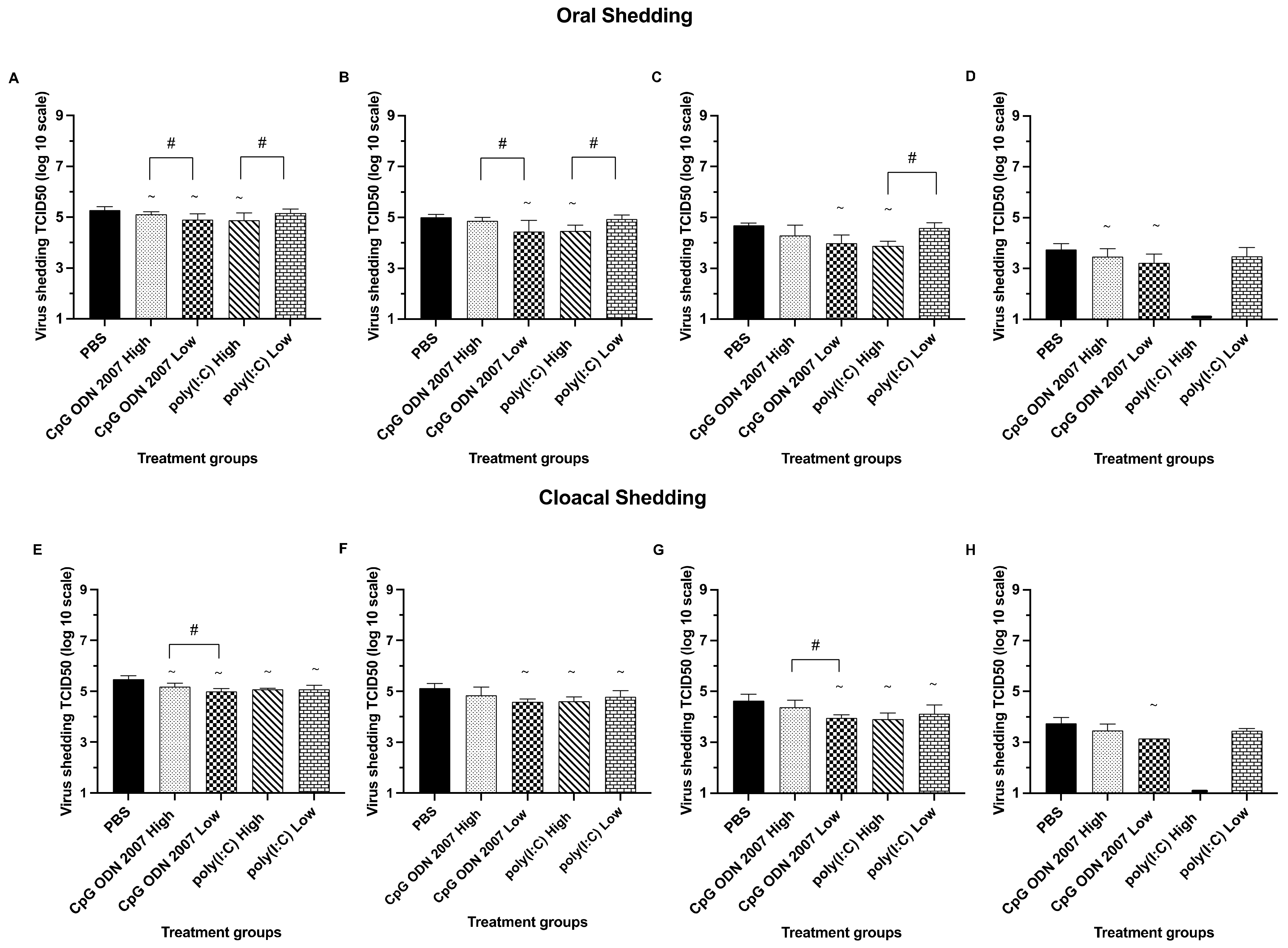
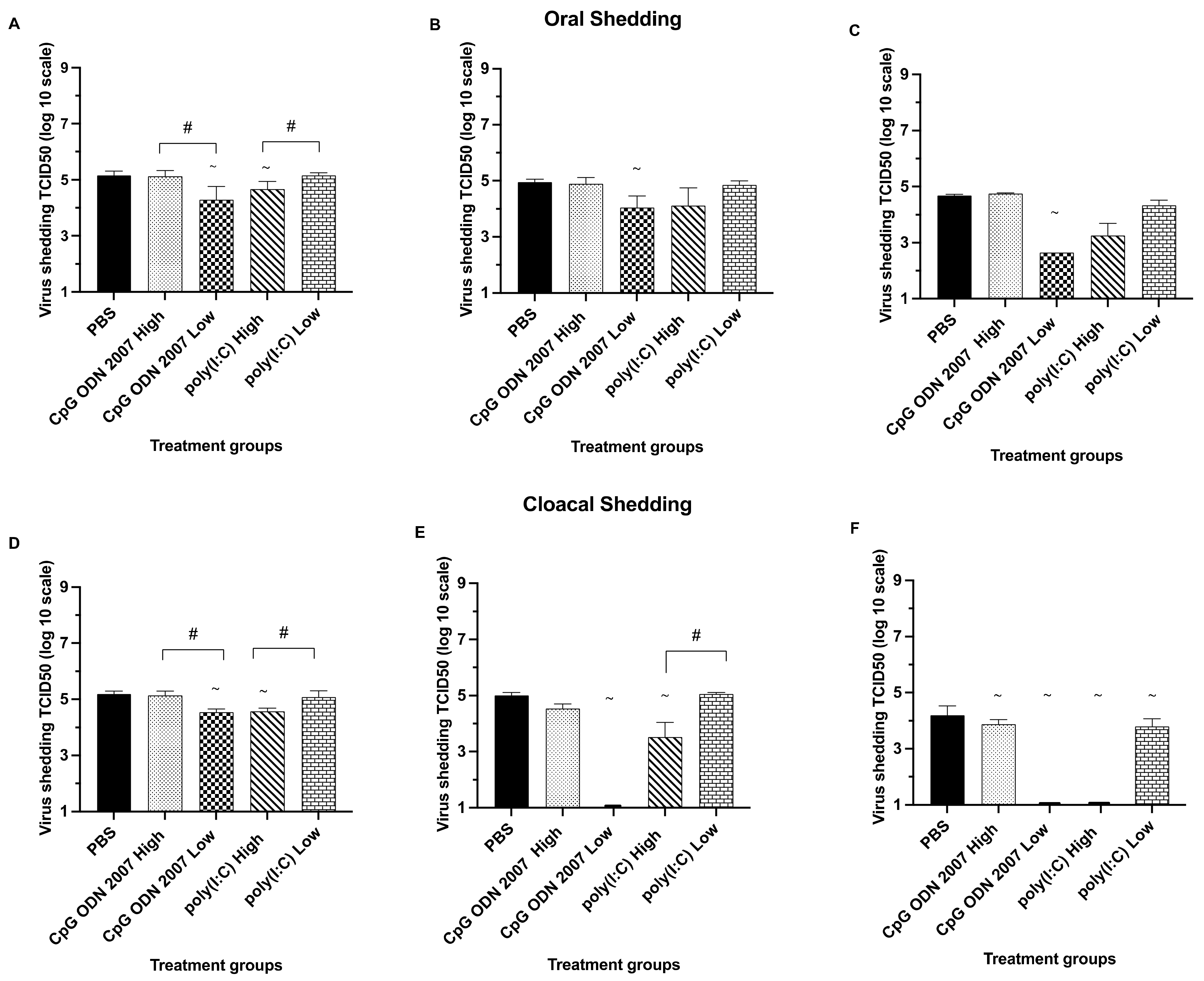
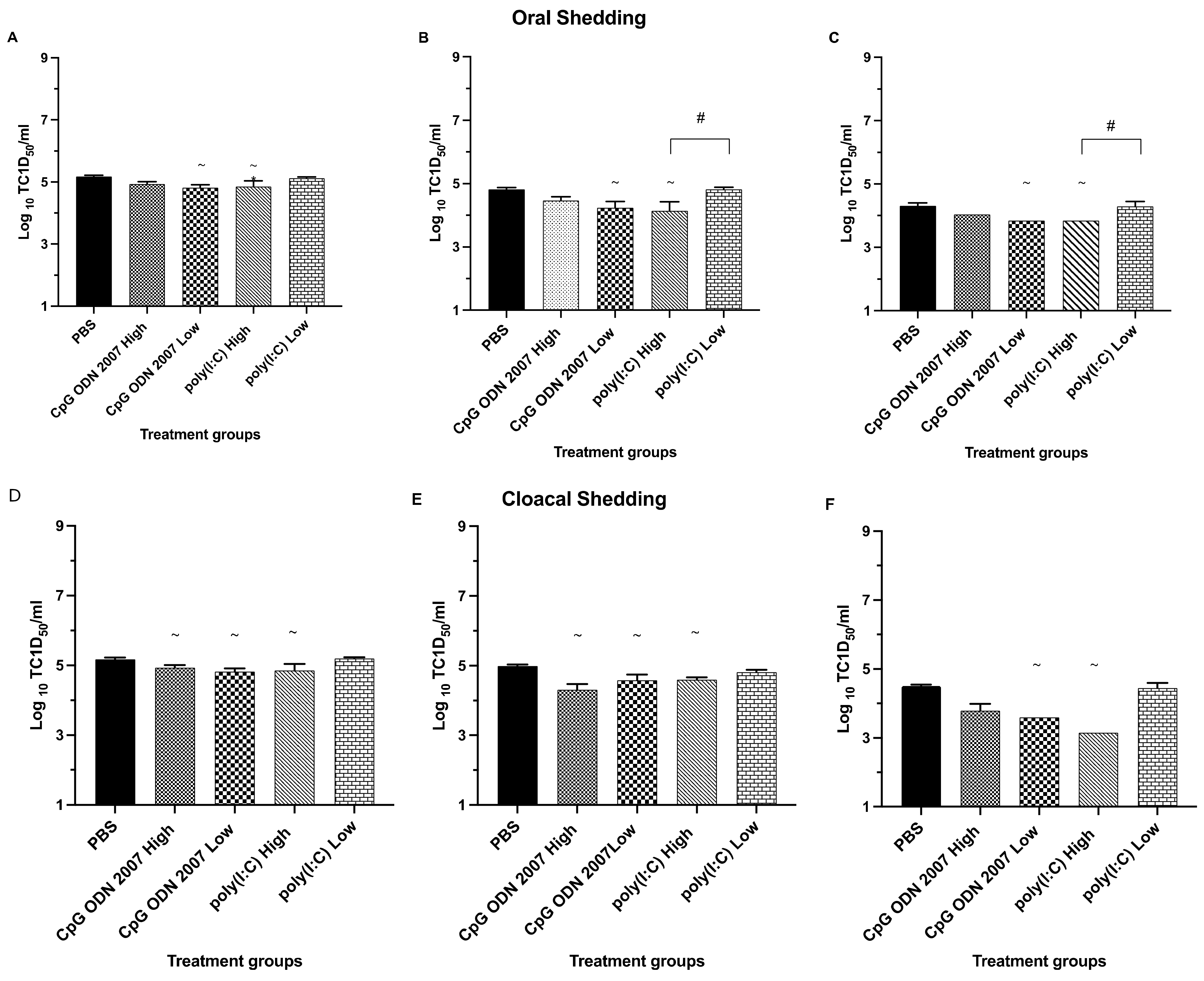
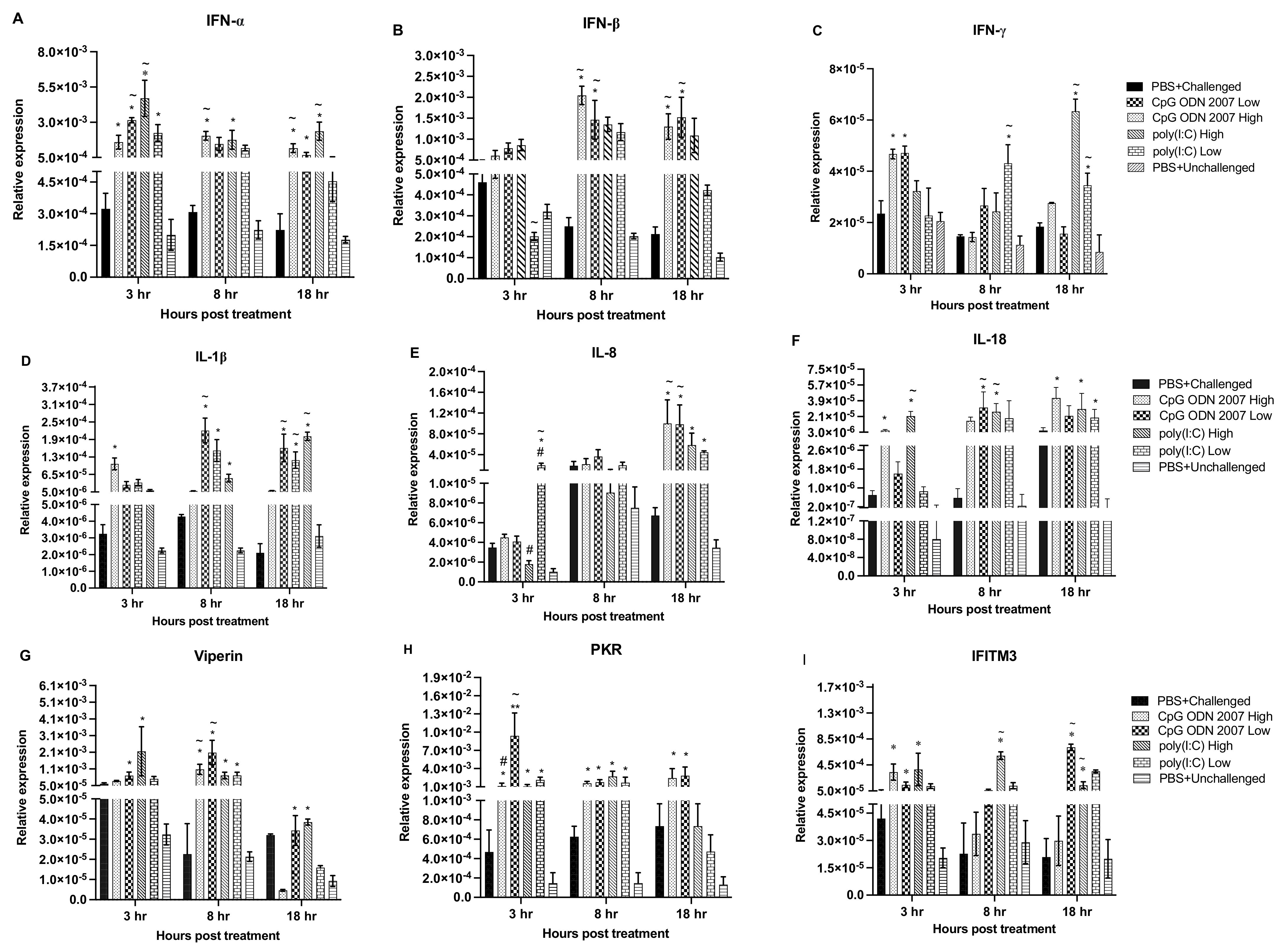

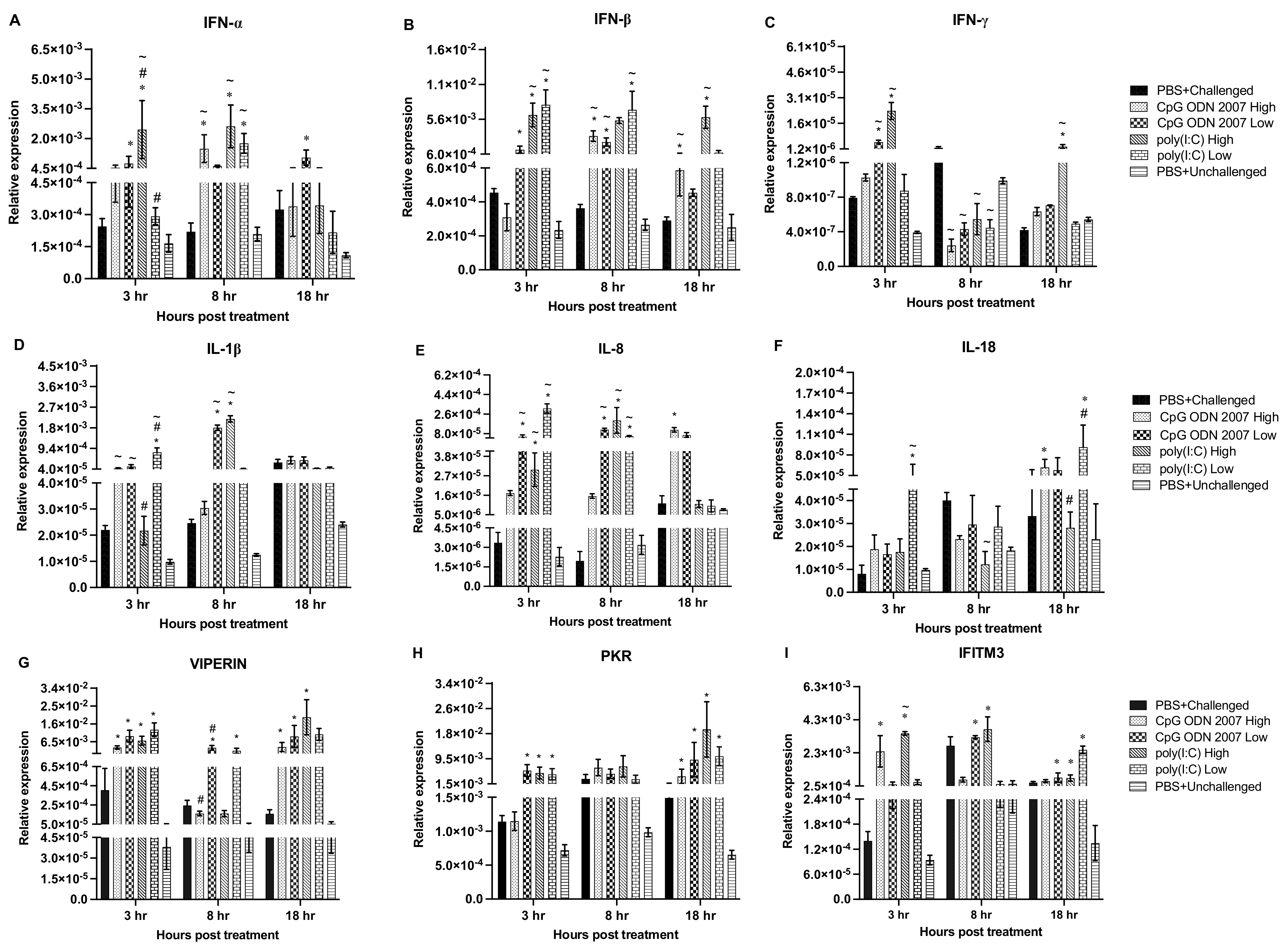
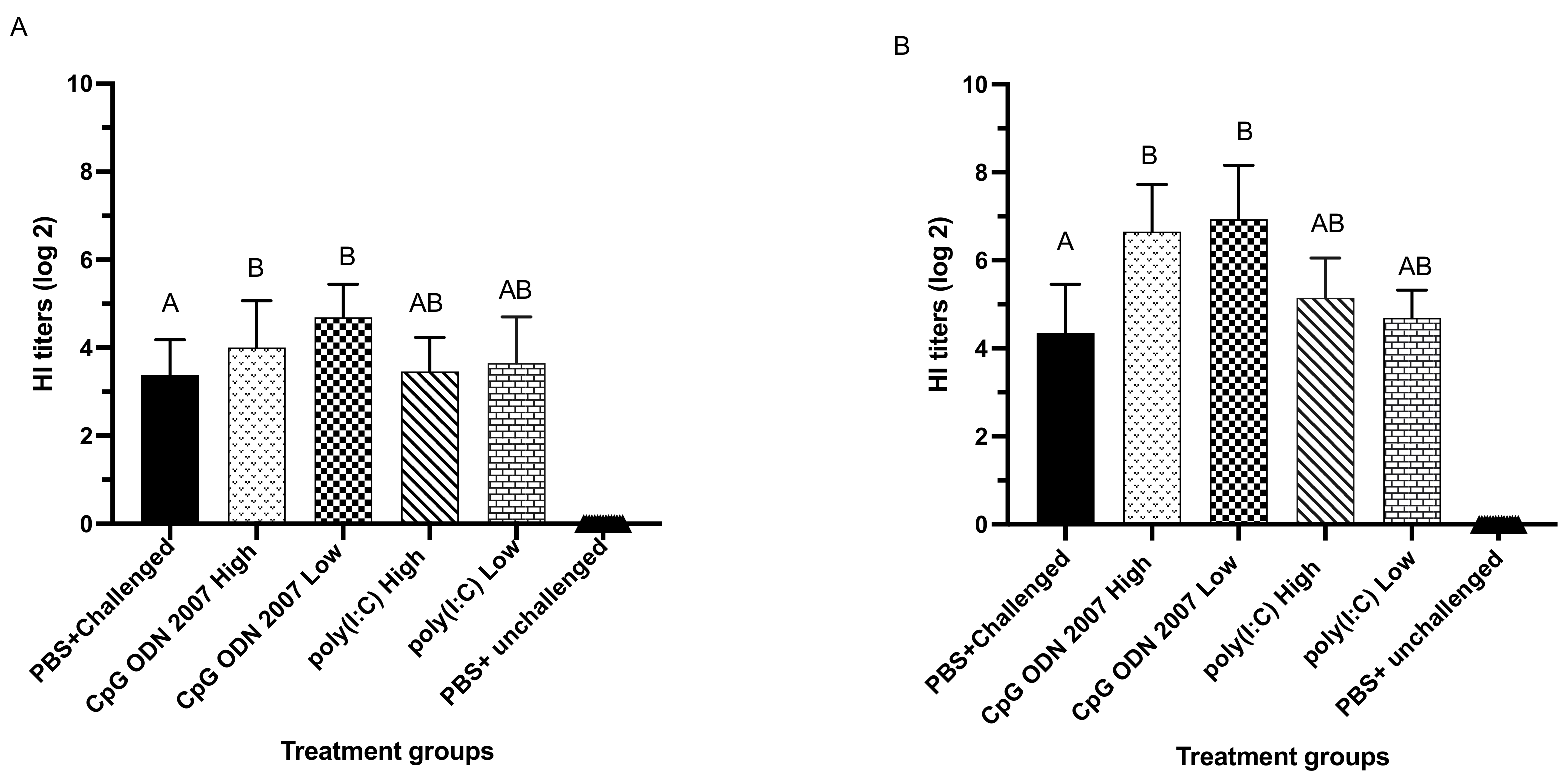
| Gene | Primer Sequence | Annealing Temperature | References |
|---|---|---|---|
| β-actin | F:5′-CAACACAGTGCTGTCTGGTGGTA-3′ R: 5′-ATCGTACTCCTGCTTGCTGATCC-3′ | 58 | [25] |
| IFN-γ | F: 5′-ACA CTG ACA AGT CAA AGC CGC ACA-3′ R: 5′-AGT CGT TCA TCG GGA GCT TGG C-3′ | 60 | [39] |
| IFN-α | F: 5′-ATCCTGCTGCTCACGCTCCTTCT-3′ R: 5′-GGTGTTGCTGGTGTCCAGGATG-3′ | 64 | [25] |
| IFN-β | F: 5′-GCCTCCAGCTCCTTCAGAATACG-3′ R: 5′-CTGGATCTGGTTGAGGAGGCTGT-3′ | 64 | [40] |
| PKR | F: 5′-TGGTACAGGCGTTGGTAAGAG-3′ R: 5′-GAGCACATCCGCAGGTAGAG-3′ | 60 | [41] |
| IFITM3 | F: 5′-CACACCAGCATCAACATGCC-3′ R: 5′-CCTACGAAGTCCTTGGCGAT-3′ | 60 | [41] |
| Viperin | F: 5′-GGAGGCGGGAATGGAGAAAA-3′ R: 5′-CAGCTGGCCTACAAATTCGC-3′ | 60 | [41] |
| IL-8 | F:5′- CCAAGCACACCTCTCTTCCA-3′ R:5′- GCAAGGTAGGACGCTGGTAA-3′ | 64 | [25] |
| IL-18 | F:5′-GAAACGTCAATAGCCAGTTGC-3′ R:5′-TCCCATGCTCTTTCTCACAACA-3′ | 64 | [42] |
| IL-1β | F:5’-GTGAGGCTCAACATTGCGCTGTA-3’ | 60 | [40] |
| R:5’-TGTCCAGGCGGTAGAAGATGAAG-3’ |
| Oral Swabs PI (Days) | CpG ODN 2007 High | CpG ODN 2007 Low | Poly(I:C) High | Poly(I:C) Low | PBS + Infec |
|---|---|---|---|---|---|
| 3 | 15/16 (93%) | 13/16 (81%) | 13/16 (81%) | 14/16 (88%) | 16/16 (100%) |
| 5 | 13/16 (81%) | 11/16 (68%) | 12/16 (75%) | 12/16 (75%) | 14/16 (88%) |
| 7 | 11/16 (68%) | 8/16 (50%) | 7/16 (43%) | 9/16 (56%) | 11/16 (68%) |
| 9 | 5/16 (31%) | 3/16 (18%) | 0/16 (0%) | 7/16 (43%) | 8/16 (50%) |
| Cloacal swabs | CpG ODN 2007 High | CpG ODN 2007 Low | poly(I:C) High | poly(I:C) Low | PBS + infec |
| 3 | 15/16 (93%) | 10/16 (62%) | 12/16 (75%) | 14/16 (88%) | 16/16 (100%) |
| 5 | 14/16 (88%) | 9/16 (56%) | 11/16 (68%) | 13/16 (81%) | 14/16 (88%) |
| 7 | 13/16 (81%) | 8/16 (50%) | 9/16 (56%) | 11/16 (68%) | 12/16 (75%) |
| 9 | 4/16 (25%) | 2/16 (12%) | 0/16 (0%) | 4/16 (25%) | 8/16 (50%) |
| Oral Swabs PI (Days) | CpG ODN 2007 High | CpG ODN 2007 Low | Poly(I:C) High | Poly(I:C) Low | PBS |
|---|---|---|---|---|---|
| 3 | 6/8 (75%) | 4/8 (50%) | 7/8 (87%) | 5/8 (62%) | 7/8 (87%) |
| 5 | 5/8 (62%) | 4/8 (50%) | 6/8 (75%) | 3/8 (38%) | 7/8 (87%) |
| 7 | 5/8 (62%) | 1/8 (12%) | 5/8 (62%) | 3/8 (38%) | 5/8 (62%) |
| 9 | 0/8 (0%) | 0/8 (0%) | 0/8 (0%) | 0/8 (0%) | 0/8 (0%) |
| Cloacal swabs | CpG ODN 2007 High | CpG ODN 2007 Low | poly(I:C) High | poly(I:C) Low | PBS + infec |
| 3 | 7/8 (87%) | 3/8 (38%) | 4/8 (50%) | 6/8 (75%) | 7/8 (87%) |
| 5 | 7/8 (87%) | 0/8 (0%) | 2/8 (25%) | 6/8 (75%) | 7/8 (87%) |
| 7 | 6/8 (75%) | 0/8 (0%) | 0/8 (0%) | 5/8 (62%) | 6/8 (75%) |
| 9 | 0/8 (0%) | 0/8 (0%) | 0/8 (0%) | 0/8 (0%) | 0/8 (0%) |
| Oral Swabs PI (Days) | CpG ODN 2007 High | CpG ODN 2007 Low | Poly(I:C) High | Poly(I:C) Low | PBS |
|---|---|---|---|---|---|
| 3 | 6 | 3 | 2 | 6 | 7 |
| 5 | 5 | 3 | 2 | 6 | 6 |
| 7 | 4 | 1 | 1 | 4 | 6 |
| 9 | 0 | 0 | 0 | 0 | 0 |
| Cloacal swabs | CpG ODN 2007 High | CpG ODN 2007 Low | poly(I:C) High | poly(I:C) Low | PBS |
| 3 | 6 | 2 | 2 | 6 | 7 |
| 5 | 5 | 2 | 2 | 6 | 6 |
| 7 | 4 | 1 | 1 | 4 | 6 |
| 9 | 0 | 0 | 0 | 0 | 0 |
Disclaimer/Publisher’s Note: The statements, opinions and data contained in all publications are solely those of the individual author(s) and contributor(s) and not of MDPI and/or the editor(s). MDPI and/or the editor(s) disclaim responsibility for any injury to people or property resulting from any ideas, methods, instructions or products referred to in the content. |
© 2023 by the authors. Licensee MDPI, Basel, Switzerland. This article is an open access article distributed under the terms and conditions of the Creative Commons Attribution (CC BY) license (https://creativecommons.org/licenses/by/4.0/).
Share and Cite
Raj, S.; Alizadeh, M.; Shoojadoost, B.; Hodgins, D.; Nagy, É.; Mubareka, S.; Karimi, K.; Behboudi, S.; Sharif, S. Determining the Protective Efficacy of Toll-Like Receptor Ligands to Minimize H9N2 Avian Influenza Virus Transmission in Chickens. Viruses 2023, 15, 238. https://doi.org/10.3390/v15010238
Raj S, Alizadeh M, Shoojadoost B, Hodgins D, Nagy É, Mubareka S, Karimi K, Behboudi S, Sharif S. Determining the Protective Efficacy of Toll-Like Receptor Ligands to Minimize H9N2 Avian Influenza Virus Transmission in Chickens. Viruses. 2023; 15(1):238. https://doi.org/10.3390/v15010238
Chicago/Turabian StyleRaj, Sugandha, Mohammadali Alizadeh, Bahram Shoojadoost, Douglas Hodgins, Éva Nagy, Samira Mubareka, Khalil Karimi, Shahriar Behboudi, and Shayan Sharif. 2023. "Determining the Protective Efficacy of Toll-Like Receptor Ligands to Minimize H9N2 Avian Influenza Virus Transmission in Chickens" Viruses 15, no. 1: 238. https://doi.org/10.3390/v15010238
APA StyleRaj, S., Alizadeh, M., Shoojadoost, B., Hodgins, D., Nagy, É., Mubareka, S., Karimi, K., Behboudi, S., & Sharif, S. (2023). Determining the Protective Efficacy of Toll-Like Receptor Ligands to Minimize H9N2 Avian Influenza Virus Transmission in Chickens. Viruses, 15(1), 238. https://doi.org/10.3390/v15010238






